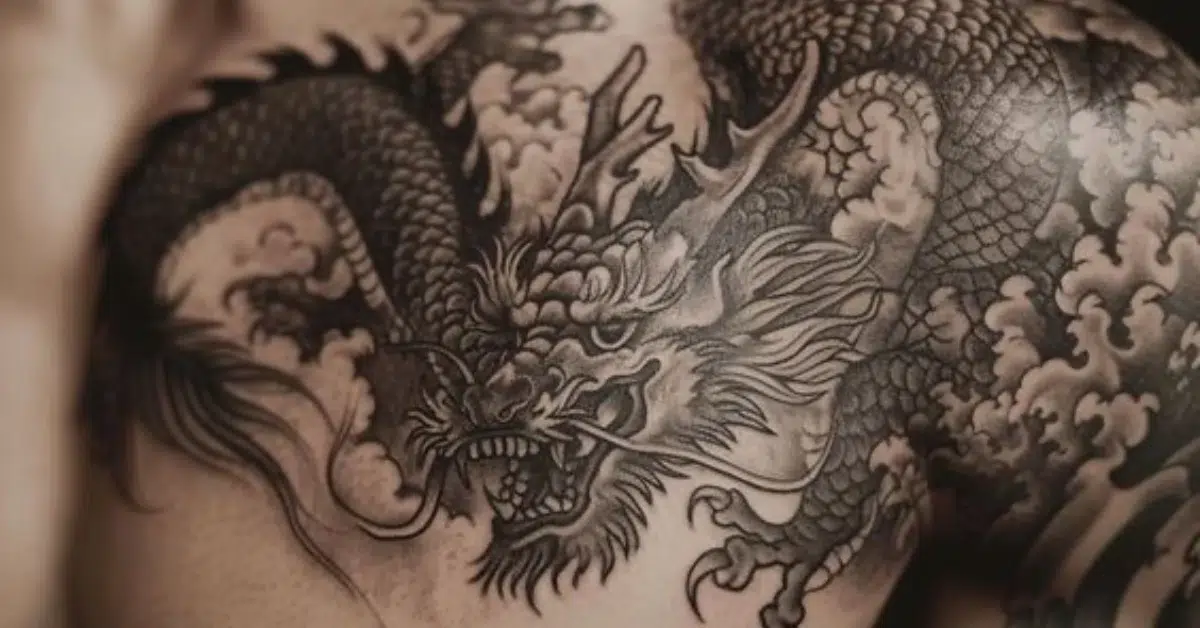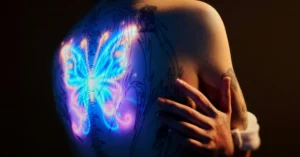In Stieg Larsson’s The Girl with the Dragon Tattoo, the protagonist Lisbeth Salander’s dragon tattoo signifies her strength and resilience, which makes it an indispensable segment of her character. That’s because dragon tattoos generally illustrate a mixture of cultural heritage, personal identity, and artistic presentation.
With their complex designs and rich symbolism, dragon tattoos have fascinated people for centuries. Therefore, we decided to discuss the history, cultural significance, and evolving styles of these tattoos in our post today. Let’s find out why dragon tattoos are still a popular and influential tattoo choice for many wearers.

Credit to @InkTat2: Where Every Mark Tells a Story | Pinterest
History of Dragon Tattoos
Dragon tattoos have a rich and varied history that spans thousands of years across many cultures. The initial examples of dragon imagery are discoverable in ancient Chinese and Japanese art. There, people know dragons as strong and benevolent creatures with a close bond with water, rain, and fertility.
These early portrayals often depicted dragons as serpentine creatures with a mixture of animal features. That said, dragons signified strength, protection, and wisdom.
On the contrary, European cultures historically illustrated dragons as fearsome, fire-breathing monsters. These dragons were present in mythologies and folklore as opponents to be slain by heroes, indicating chaos and destruction. Medieval knights and saints—like St. George—were usually portrayed fighting these frightening beasts, which empowers the role of dragons as an emblem of evil.
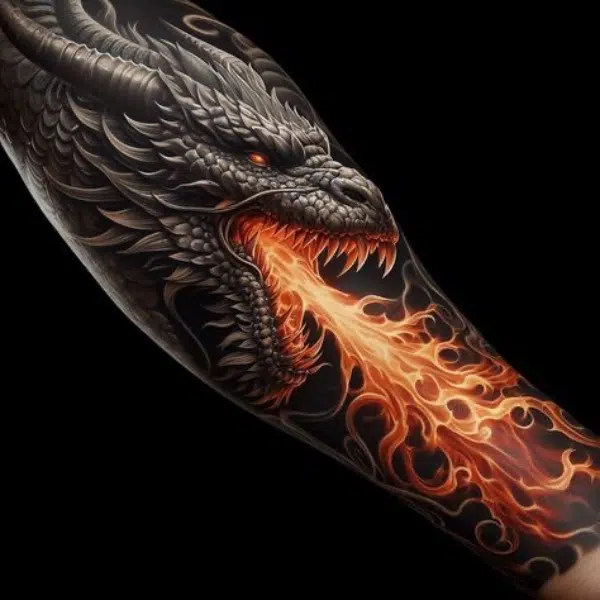
Credit to @Jean R. Albertson | Pinterest
As tattoo art transformed, these cultural descriptions inspired tattoo designs. Sailors in the 18th and 19th centuries loved dragon tattoos and their encounters with Asian cultures and maritime myths. They wore these tattoos as talismans that could offer protection during eventful sea voyages.
The convergence of Eastern and Western dragon imagery in tattoo art has given birth to diverse combinations of styles, each with specific historical roots and cultural significance. This convergence continues to expand, proving the long-lasting attraction of the dragon motif in tattoo culture.
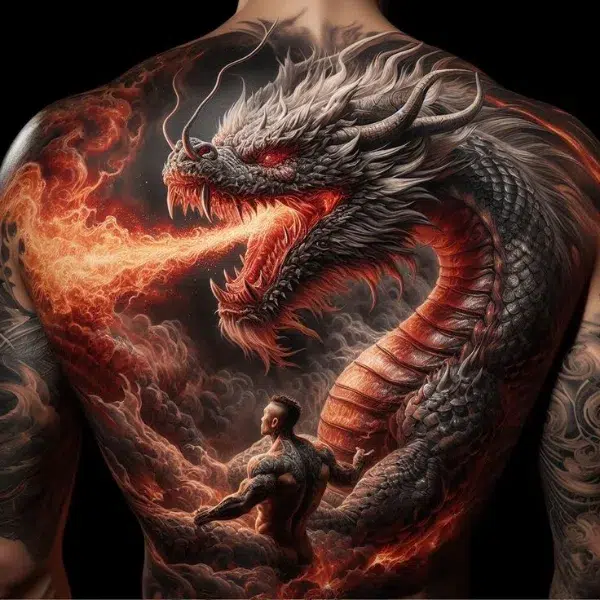
Credit to @Rare AI | Pinterest
Cultural Significance of Dragons
Dragons convey critical cultural messages across different regions. They signify a broad spectrum of attributes and beliefs.
Asian Cultures
In Asian cultures—particularly in China and Japan—people praise dragons as influential and auspicious creatures. Chinese dragons are widely comprehended as benevolent creatures that bring good fortune, strength, and prosperity. There are close bonds between dragons and water because people believed they could control rain, floods, and other water-related phenomena integral to agriculture.
In Chinese mythology, dragons also signify the emperor’s power and divine right to rule. They are illustrated as serpentine creatures with the characteristics of different animals, thereby exemplifying harmony and balance.
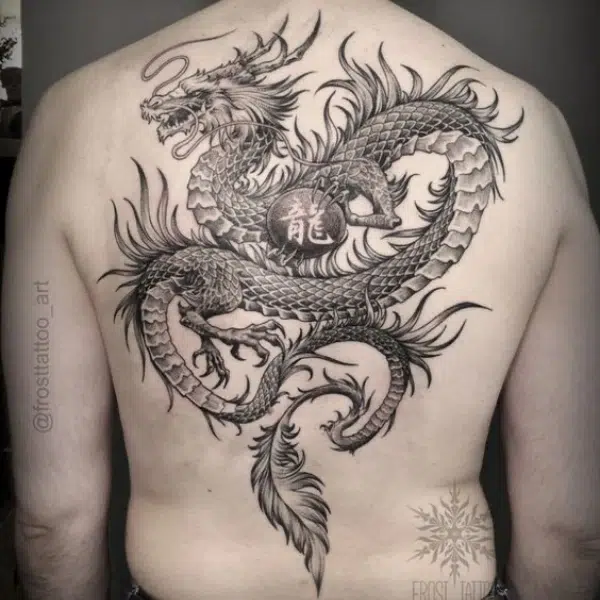
Credit to @Nkara | Pinterest
Japanese dragons are somewhat similar, but they convey unique messages. Japanese believed these creatures were intelligent and protective, often living as guardians of treasures and sacred places.
Furthermore, in Japanese art, dragons are repeatedly characterized as more serpentine than their Chinese counterparts. More often than not, deep connections exist between these creatures and water bodies like rivers and oceans. The cultural respectability for dragons in Japan is vividly observable in diverse festivals and rituals.
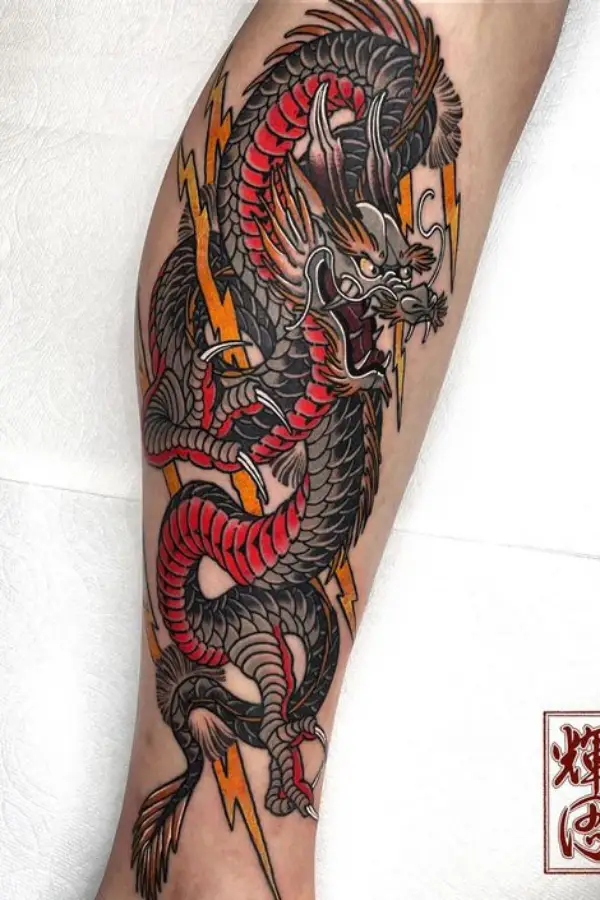
Credit to @Tattoos with Ink Happened | Pinterest
Western Cultures
Contrarily, Western cultures historically view dragons as symbols of fear and awe. European dragons—often illustrated as monstrous and vicious—are the central core of numerous myths and legends. These dragons generally exemplify chaos, destruction, and evil.
Tales of knights and saints slaying dragons, including the legend of St. George, indicate the victory of good over evil. This contradiction between Eastern and Western dragon symbolism demonstrates the rich and mixed interpretations of dragons across different cultures.
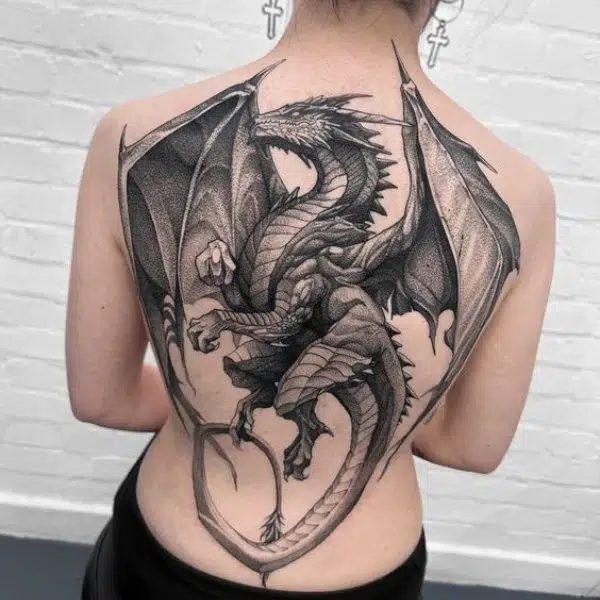
Source: https://www.pinterest.com/pin/56576539063108276/
Dragon Tattoos in Modern Culture
Today, dragon tattoos are a major element in contemporary tattoo art. They echo both ancient traditions and modern creativity. Highly popular globally, these tattoos come with unique interpretations of the dragon motif in every culture. In the contemporary era, wearers cherish dragon tattoos for their detailed designs and profound symbolism.
The impact of media and celebrities has enormously reformed the modern interpretation of dragon tattoos. Iconic figures with dragon tattoos have depicted these tattoos in diverse public and artistic domains. Movies, books, and television shows featuring dragons—including Game of Thrones and The Girl with the Dragon Tattoo—have popularized this motif even more as they have entangled the mythical creature with contemporary descriptions of power, mystery, and rebellion.
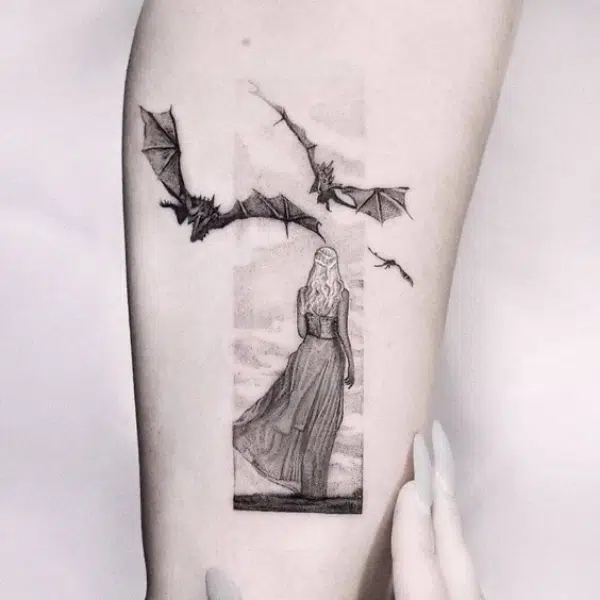
Credit to @Outsons | Pinterest
In their dragon imagery, modern tattoo artists today blend traditional elements with new stylistic techniques. The outcome is a diverse set of dragon tattoo styles, from hyper-realistic definitions to abstract and minimalist interpretations. This versatility helps wearers pick designs that fit their personality, like a sign of strength, protection, or personal transformation.
Dragon tattoos are also a powerful sign of self-expression and identity. Countless wearers use these tattoos to connect with their cultural heritage or to symbolize things they admire, such as courage and wisdom.
Choosing and getting a dragon tattoo generally contains deep personal considerations, making them an influential and transformative experience. In modern culture, dragon tattoos still conserve their timeless charm, and at the same time, adapt to contemporary tastes.

Source: https://www.heyuguys.com/exclusive-behind-the-scenes-featurette-for-the-girl-with-the-dragon-tattoo/
The Girl with the Dragon Tattoo: A Cultural Phenomenon
The Girl with the Dragon Tattoo—originally titled Män som hatar kvinnor (Men Who Hate Women) in Swedish—is the first novel in Stieg Larsson’s praised Millennium Trilogy. It was published posthumously in 2005 and immediately led to flourishing film adaptations in Sweden and Hollywood.
Lisbeth Salander is the enigmatic protagonist at the heart of this phenomenon. The dragon tattoo on her back is as iconic as her character. Her tattoo has multiple layers of symbolism, including her fierce independence and resilience against a world that always mistreated her.
The dragon aligns well with Lisbeth’s transformation and survival because it symbolizes her innate struggle and defiance. It is not just a physical mark; it is a narrative that calls attention to her complexity and shows her hidden depths and innate fire.

Source: https://en.wikipedia.org/wiki/Men_Who_Hate_Women_(Bates_book)
The novel and its following adaptations have enormously impacted popular culture, hence the elevation of the dragon tattoo as a mark of empowerment and rebellion. Lisbeth’s character enchanted audiences with her combined defenselessness and strength. Her dragon tattoo became a visible sign of her indestructible spirit and her fight against societal mistreatment.
In addition to its role in the narrative, The Girl with the Dragon Tattoo maximized the popularity of dragon tattoos. The story’s dark and intricate plot and the complexity of its characters attracted many. It inspired them to discover analogous themes in their lives and even get dragon tattoos as a homage to Lisbeth’s character.
Furthermore, the cultural phenomenon of The Girl with the Dragon Tattoo spotlights the long-lasting charm of dragon imagery. It shows how the motif can be reinterpreted and recontextualized to contemplate contemporary melodies of empowerment, identity, and resistance. This connection has stabilized the dragon tattoo as a strong mark in modern storytelling and personal identity.
Dragon Tattoo Designs and Styles
Dragon tattoo designs and styles are enormously diverse. They mirror the rich cultural heritage and developing artistry behind these mythical creatures.
- Chinese Dragon Tattoos: These tattoos feature serpentine bodies with complex scales, flowing manes, and a unified combination of animal features like deer antlers and eagle claws. They are generally intricate and accommodate power, wisdom, and protection meanings.
- Japanese Dragon Tattoos: Also known as Ryu, these tattoos are also detailed but often come with elements such as clouds and water to show their bond with natural forces. These tattoos are generally large to cover essential body parts and use energetic colors to create eye-catching visuals.
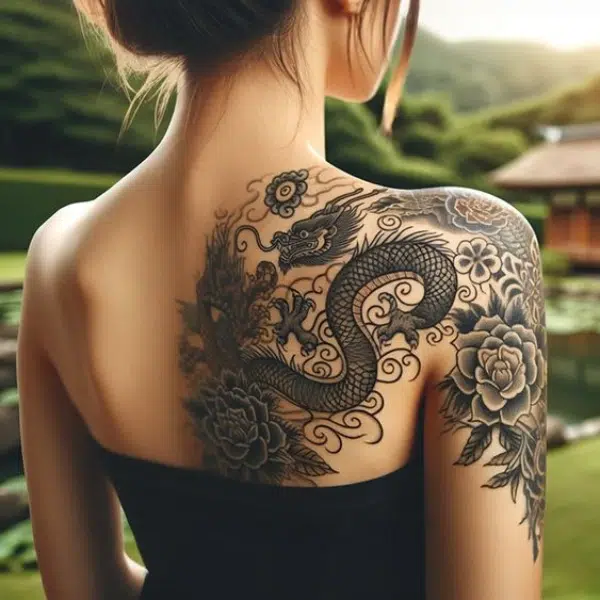
Credit to @Stylecraze | Pinterest
- Western Tattoo Art: In these tattoos, dragons are often frightening creatures that breathe fire. They usually contain wings, sharp claws, and intense expressions to exemplify strength, chaos, and the battle between good and evil.
- Celtic Dragon Tattoos: These tattoos are distinguished by complicated knotwork and figurative entangling patterns that depict immortality and the interconnectedness of life.
- Modern Dragon Tattoos: These modern interpretations include hyper-realistic depictions and minimalist and abstract designs. Some wearers pick black and grey tattoos for a more serene and classic look, while others may choose colorful variants for a bolder message.
Choosing a Dragon Tattoo
Choosing a dragon tattoo contains several steps to make sure it matches your personality and aesthetics:
- Understand the Symbolism: Search for cultural meanings of dragon portrayals (for example, Chinese for power, Japanese for protection, Western for defiance, and more).
- Select a Style: Choose from traditional (Chinese, Japanese, Celtic) or modern (hyper-realistic, minimalist) designs. Pick one that fits your values and aesthetic inclinations.
- Find a Tattoo Artist: Find a specialized artist in dragon tattoos. Review their portfolios and schedule consultations so you can talk about your ideas.
- Decide on Placement: Choose an area of your body that can house the size and detail of the design (for example, back, arms, or thighs). Make sure the placement aligns with your lifestyle and comfort status.
- Prepare and Tattoo Aftercare: Follow your artist’s pre-tattoo and aftercare instructions. This is a crucial step to healing and maintaining your tattoo.

Source: https://www.pinterest.com/pin/316448311321613923/
Final Words
Dragon tattoos combine cultural heritage, personal significance, and artistic manifestation. Their ancient origins in Chinese and Japanese traditions and modern interpretations of Western art stabilize their fascination and inspiration.
The Girl with the Dragon Tattoo has strengthened the dragon’s symbolic status even more, characterizing it as a mark of strength and empowerment. Dragon tattoos continue to reshape, but they remain a timeless tattoo choice that symbolizes the strength and identity of the wearer.
